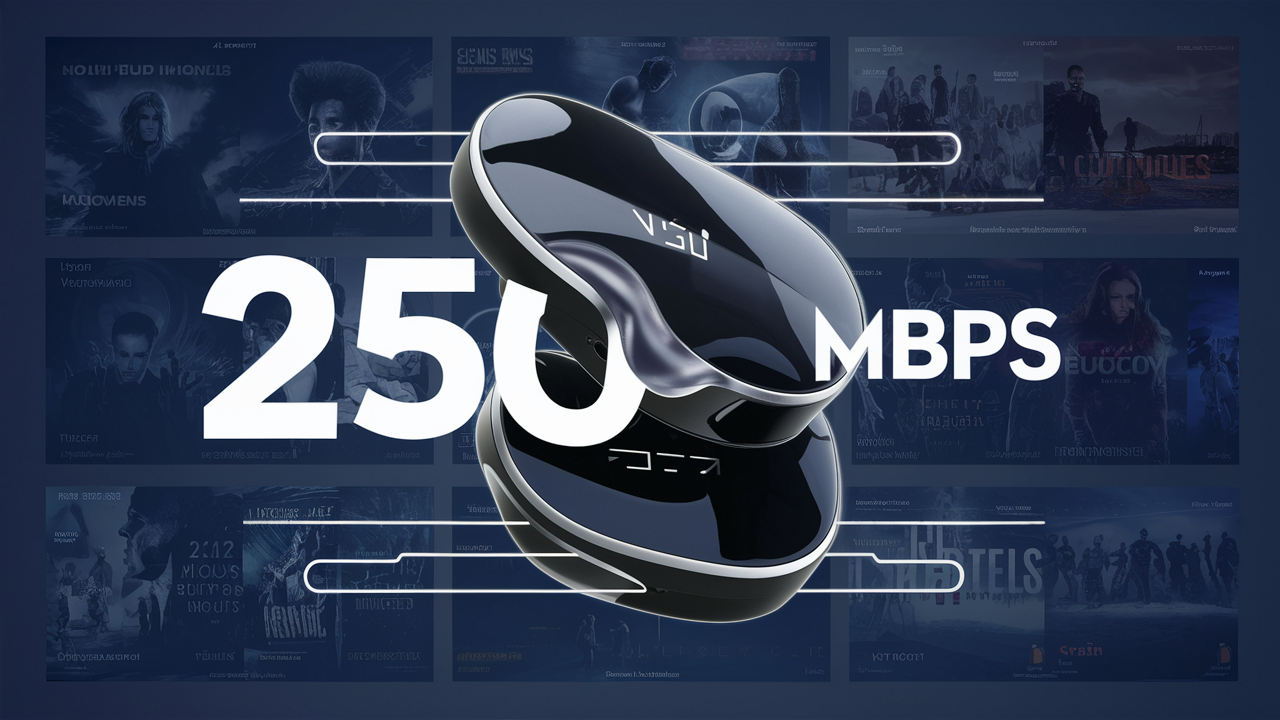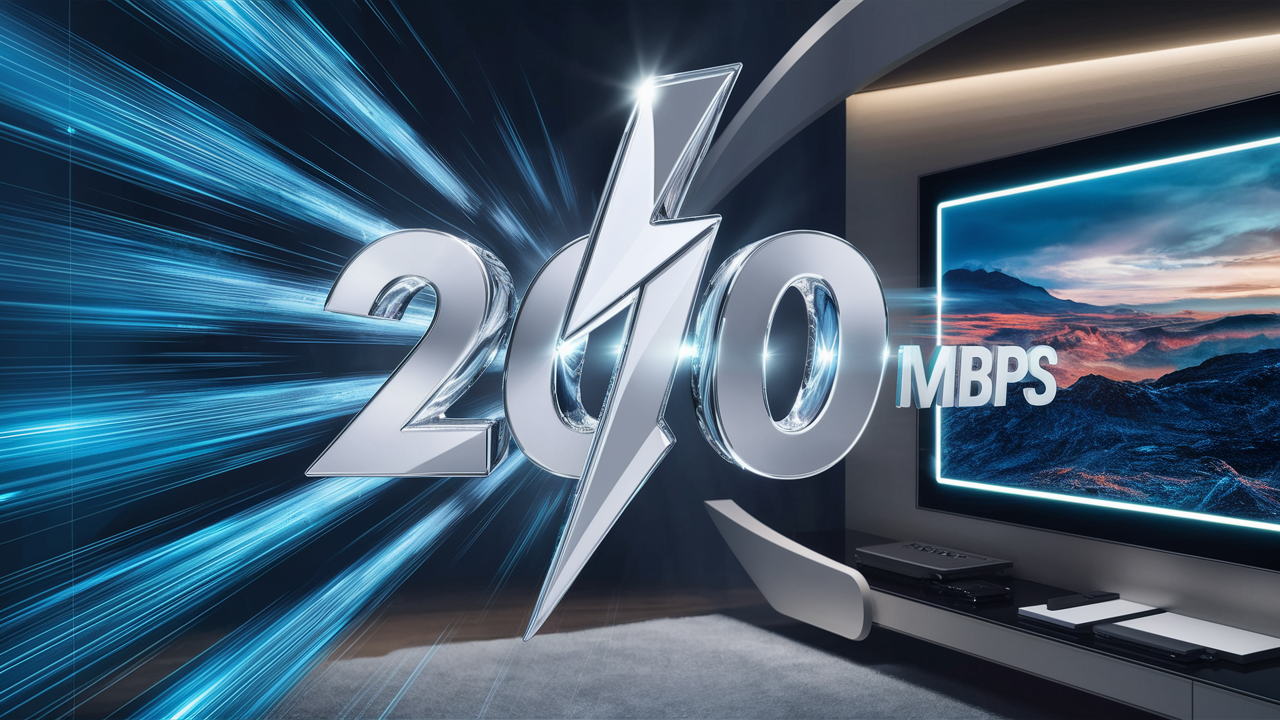Is 250 Mbps Fast Enough for Streaming?

For most households in 2025, 250 Mbps internet speed is more than sufficient for a smooth, buffer-free streaming experience, even with multiple devices active. This speed offers a robust balance of performance and affordability, catering to a wide range of online activities beyond just watching your favorite shows.
Understanding Internet Speeds: Mbps Explained
Before diving into whether 250 Mbps is sufficient for your streaming needs, it's crucial to understand what "Mbps" actually means. Mbps stands for Megabits per second, and it's the standard unit for measuring the speed of your internet connection. This measurement indicates how much data can be transferred between your device and the internet in one second. A higher Mbps number signifies a faster connection, allowing for quicker downloads, smoother uploads, and more robust online activities.
Internet speeds are typically divided into two categories: download speed and upload speed. For streaming, the download speed is the most critical. It determines how quickly content from streaming servers can be sent to your device. Upload speed, on the other hand, is more relevant for activities like video conferencing, online gaming where you're sending data, or uploading large files to cloud storage. While both are important for a well-rounded internet experience, streaming primarily relies on the download capacity.
The "Megabits" part refers to the unit of data. A megabit (Mb) is one-eighth of a megabyte (MB), which is a common unit for file sizes. This distinction is important because sometimes internet plans are advertised with speeds in megabytes, which can be confusing. However, Mbps is the industry standard for connection speeds. Therefore, a 250 Mbps connection means your internet can theoretically download 250 megabits of data every second.
In 2025, internet speeds have become increasingly sophisticated. Many providers offer tiered plans with varying Mbps, and understanding these tiers is key to choosing the right plan for your household's specific needs. The perceived speed can also be influenced by factors beyond just the advertised Mbps, such as network congestion, the quality of your router, and the distance to the nearest server. However, the raw Mbps number provides a fundamental benchmark for evaluating your internet's capability.
How Much Speed Do Streaming Services Really Need?
The bandwidth requirements for streaming services vary significantly based on the quality of the content you're watching and the specific platform. These requirements are often expressed in Mbps, making it easy to compare them to your internet plan. Understanding these baseline needs is the first step in determining if 250 Mbps is adequate.
Here's a breakdown of typical bandwidth recommendations from major streaming providers as of 2025:
- Netflix:
- 0.5 Mbps for a minimum connection speed.
- 1.5 Mbps for SD quality.
- 3.0 Mbps for HD quality.
- 7.0 Mbps for 4K UHD quality.
- YouTube:
- 2.5 Mbps for HD quality.
- 3.5 Mbps for 4K quality.
- Hulu:
- 1.5 Mbps for SD quality.
- 3.0 Mbps for HD quality.
- 6.0 Mbps for 4K UHD quality.
- Amazon Prime Video:
- 1.5 Mbps for SD quality.
- 3.5 Mbps for HD quality.
- 15 Mbps for 4K UHD quality.
- Disney+:
- 5 Mbps for HD quality.
- 25 Mbps for 4K UHD quality.
- HBO Max (now Max):
- 5 Mbps for HD quality.
- 8 Mbps for 4K UHD quality.
It's important to note that these are the minimum recommended speeds for a smooth experience. To ensure consistent, buffer-free playback, especially during peak usage times or when multiple people are streaming simultaneously, it's always advisable to have a connection that significantly exceeds these minimums. For instance, while 3 Mbps might be enough for one person to stream HD, having 10 Mbps available would provide a much more reliable experience.
The resolution of the video is the primary driver of bandwidth consumption. Standard Definition (SD) requires the least bandwidth, followed by High Definition (HD), and then 4K Ultra High Definition (UHD), which demands the most. Beyond video, audio quality also plays a minor role, with higher fidelity audio codecs consuming slightly more data. However, the visual aspect is the dominant factor.
Furthermore, some streaming services may have additional bandwidth requirements for features like live streaming events or interactive content, which are becoming more prevalent in 2025. These can sometimes push the required speeds higher than standard on-demand viewing.
Is 250 Mbps Enough for Different Streaming Scenarios?
Now, let's directly address the core question: Is 250 Mbps fast enough for streaming? The answer, for the vast majority of households in 2025, is a resounding yes. Let's break down why by considering various common scenarios.
Scenario 1: A Single User Streaming in 4K UHD
If you're the only one in the household watching content, and you prefer the highest possible quality, 250 Mbps is more than adequate. Even the most demanding 4K streams, like those on Disney+ or Amazon Prime Video, typically require around 25 Mbps for optimal playback. With 250 Mbps, you have ten times that amount available, leaving ample room for other background internet activities.
Scenario 2: A Couple Streaming in HD Simultaneously
Imagine a couple, each watching a different HD show on separate devices. If each HD stream requires, say, 5 Mbps (a generous estimate for most services), that's a total of 10 Mbps. Even if one of them decides to stream in 4K (25 Mbps), the total demand would be around 30 Mbps. A 250 Mbps connection can easily handle this, with plenty of bandwidth left over.
Scenario 3: A Family with Multiple Devices Streaming and Gaming
This is where a 250 Mbps connection truly shines. Consider a family with two children playing online multiplayer games (which can consume anywhere from 3-5 Mbps each), one parent streaming a 4K movie (25 Mbps), and another parent on a video call for work (typically 5-10 Mbps for HD quality). The total estimated bandwidth usage would be around 16-25 Mbps. This is well within the capabilities of a 250 Mbps connection, even with other devices like smartphones and tablets browsing the web.
Scenario 4: Heavy Users with Multiple 4K Streams
Even in a household with several power users, 250 Mbps can hold its own. If you have four simultaneous 4K streams, each consuming 25 Mbps, that's a total of 100 Mbps. This still leaves 150 Mbps for other activities, such as downloading large files, online gaming, or general web browsing. This scenario represents a very high demand, and 250 Mbps handles it gracefully.
Scenario 5: Households with Smart Home Devices
Modern smart homes in 2025 are filled with connected devices: smart thermostats, security cameras, smart speakers, smart TVs, and more. While these devices don't consume massive amounts of bandwidth individually, their cumulative effect can add up. A 250 Mbps connection provides enough headroom to support these devices without impacting your primary streaming or browsing experience. For example, a security camera streaming HD footage might use around 1-2 Mbps, and a smart speaker uses negligible bandwidth.
The key takeaway is that 250 Mbps offers a substantial buffer. Even when accounting for the recommended speeds for multiple high-quality streams and other internet activities, you are unlikely to hit the bandwidth ceiling with this speed tier. This provides a comfortable and reliable experience for almost any typical household in 2025.
Factors Affecting Your Actual Streaming Experience
While your advertised internet speed is a crucial factor, it's not the only determinant of your streaming quality. Several other elements can influence how smoothly your videos play. Understanding these can help you troubleshoot issues and ensure you're getting the most out of your 250 Mbps connection.
1. Wi-Fi vs. Ethernet:
A wired Ethernet connection is almost always faster and more stable than a Wi-Fi connection. Wi-Fi signals can be affected by distance from the router, physical obstructions (walls, furniture), and interference from other electronic devices. If you're experiencing buffering on a device that's far from your router, try moving closer or using an Ethernet cable if possible. For critical streaming devices like a smart TV or a dedicated streaming box, a wired connection is highly recommended.
2. Router Quality and Age:
Your router is the gateway to your internet. An old or low-quality router can become a bottleneck, even if you have a fast internet plan. Modern routers support newer Wi-Fi standards (like Wi-Fi 6 or Wi-Fi 6E in 2025) that offer higher speeds, better range, and improved efficiency in handling multiple devices. Ensure your router is up-to-date and capable of supporting your internet speed.
3. Network Congestion (Your Home Network):
Even with 250 Mbps coming into your home, if multiple devices are simultaneously demanding bandwidth (e.g., large downloads, intense online gaming, multiple high-definition streams), your home network can become congested. This is different from your Internet Service Provider's (ISP) network congestion. Your router manages the traffic within your home. Using Quality of Service (QoS) settings on your router can help prioritize streaming traffic over other less time-sensitive activities.
4. ISP Network Congestion:
During peak hours (typically evenings and weekends), your ISP's network can become congested as more people in your area are online. This can lead to slower speeds than you're paying for, even if your home network is optimized. Some ISPs offer plans with "no data caps" or "unlimited data" which may also come with "network management" policies during peak times. For 250 Mbps, this is less likely to be a significant issue compared to lower speed tiers, but it's still a possibility.
5. Device Performance:
The device you're streaming on also plays a role. An older smart TV or a slow streaming stick might struggle to decode high-resolution video streams, leading to stuttering or buffering, even with a fast internet connection. Ensure your streaming devices are up-to-date and capable of handling the video quality you're trying to achieve.
6. Server-Side Issues:
Sometimes, the problem isn't with your internet connection or your home network, but with the streaming service's servers. If a particular show or movie is experiencing issues on the server end, it can cause playback problems for everyone. Checking social media or other user forums can sometimes reveal if a service is experiencing widespread technical difficulties.
7. Background Downloads and Updates:
Operating system updates, game downloads, or cloud backups running in the background can consume significant bandwidth. These activities can drastically reduce the available bandwidth for streaming. It's advisable to schedule these large downloads for times when you're not actively streaming or to pause them temporarily.
By considering these factors, you can better understand why you might occasionally experience less-than-perfect streaming and take steps to mitigate those issues, ensuring your 250 Mbps connection delivers the best possible performance.
Comparing 250 Mbps to Other Speeds
To truly appreciate the value of 250 Mbps, it's helpful to compare it to other common internet speed tiers available in 2025. This comparison highlights where 250 Mbps sits in the spectrum of home internet performance.
1. Lower Speed Tiers (e.g., 50-100 Mbps):
These speeds are generally considered adequate for basic internet use, including streaming HD content for one or two devices. However, they can quickly become a bottleneck in a multi-device household. With 50-100 Mbps, you might experience buffering if multiple people are streaming simultaneously, especially in 4K, or if other bandwidth-intensive activities are occurring. Downloading large files can also take a considerable amount of time. 250 Mbps offers roughly 2.5 to 5 times the capacity of these lower tiers, providing a much more robust and future-proof experience.
2. Mid-Range Tiers (e.g., 300-500 Mbps):
This is the tier just above 250 Mbps. These speeds are excellent and can comfortably handle almost any home internet demand, including multiple 4K streams, extensive online gaming, and heavy file sharing. For a typical family, the difference in streaming performance between 250 Mbps and 300-500 Mbps might be negligible. However, if you have a very large household with numerous simultaneous high-demand activities or if you frequently download very large files, the higher speeds might offer a slight edge in responsiveness and download times.
3. High-End and Gigabit Tiers (e.g., 1 Gbps and above):
Gigabit speeds (1000 Mbps) and beyond are considered top-tier. These speeds are overkill for most residential streaming needs. While they offer the absolute fastest download and upload speeds available, the practical difference for streaming movies or TV shows compared to 250 Mbps is often imperceptible. These speeds are primarily beneficial for households with extreme internet usage, such as professional content creators, large businesses operating from home, or those who download massive files (e.g., terabytes of data) regularly. For the average user, the cost premium for gigabit speeds often doesn't justify the marginal improvement in streaming quality.
Table: Speed Tier Comparison for Streaming (2025 Estimates)
| Speed Tier | Typical Use Cases | Streaming Performance | Notes |
|---|---|---|---|
| 50-100 Mbps | Basic browsing, HD streaming (1-2 devices), social media | Adequate for single HD streams; may buffer with multiple devices or 4K | Budget-friendly, but limited for demanding households |
| 250 Mbps | HD & 4K streaming (multiple devices), online gaming, video conferencing, general use | Excellent; handles multiple 4K streams and other activities smoothly | Strong balance of speed, cost, and performance for most users |
| 300-500 Mbps | Heavy 4K streaming, extensive gaming, large file downloads, smart home tech | Excellent; provides significant headroom for very demanding households | Slightly more expensive than 250 Mbps, with diminishing returns for average users |
| 1 Gbps+ | Professional content creation, extremely large file transfers, hyper-connected smart homes | Overkill for typical streaming; offers fastest possible downloads | Premium pricing, best for specialized high-demand needs |
In essence, 250 Mbps represents a sweet spot in internet speeds for 2025. It offers significantly more capability than basic plans, ensuring a premium streaming experience without the potentially unnecessary expense of gigabit-level speeds. It provides the power needed for today's high-definition content and the flexibility to handle multiple users and devices concurrently.
Real-World 2025 Streaming Performance with 250 Mbps
Let's move beyond theoretical numbers and explore what 250 Mbps actually feels like for streaming in the current digital landscape of 2025. Anecdotal evidence and performance benchmarks consistently show that 250 Mbps delivers a superior streaming experience for the majority of users.
Instant Buffering and Seamless Playback:
When you click play on a movie or show with a 250 Mbps connection, you'll typically experience near-instantaneous playback. The video will load quickly, and buffering will be a rare occurrence, if it happens at all. This is because the connection can download the necessary video data far faster than it's being played, allowing for a substantial buffer to be built up ahead of time. This buffer acts as a safety net against minor network fluctuations.
High-Resolution Streaming Without Compromise:
Watching content in 4K Ultra HD, HDR (High Dynamic Range), and even Dolby Vision becomes a seamless experience. These formats offer stunning visual fidelity but require more bandwidth. A 250 Mbps connection provides ample headroom for even the most demanding 4K streams, ensuring you can enjoy the crispest details and most vibrant colors without interruption. You can have multiple 4K streams running simultaneously across different devices without noticing a degradation in quality.
Multitasking Capabilities:
The true power of 250 Mbps is revealed when you're multitasking. Imagine one person is engrossed in a 4K nature documentary, while another is catching up on their favorite sitcom in HD. Simultaneously, a teenager is engaged in a fast-paced online multiplayer game, and another family member is on a video conference call for work. With 250 Mbps, all these activities can coexist harmoniously. The speed allows for the prioritization of critical traffic (like gaming or video calls) while still ensuring smooth delivery of high-quality video streams. This level of performance prevents the common frustration of lagging games or choppy video calls that plague lower-speed connections.
Download Speeds for Offline Viewing:
Beyond live streaming, 250 Mbps significantly speeds up the process of downloading content for offline viewing. Services like Netflix, Amazon Prime Video, and Disney+ allow you to download movies and shows to your devices. With 250 Mbps, downloading a feature-length film in HD can take just a few minutes, and even a 4K movie might only take 10-15 minutes, depending on file size and server speeds. This is a massive improvement over slower connections where downloading a single movie could take an hour or more.
Future-Proofing:
As video resolutions continue to increase and streaming technologies evolve (e.g., higher frame rates, more immersive audio formats), bandwidth demands will likely grow. A 250 Mbps connection in 2025 is robust enough to handle these anticipated increases for the foreseeable future for most households. It provides a comfortable buffer that will allow you to enjoy new streaming features and content formats without immediately needing an internet speed upgrade.
Example Scenario: A Busy Saturday Night
Consider a typical Saturday night in 2025. The family is home. Dad is watching a live sports event in 4K on the living room TV. Mom is on a video call with her parents in HD. Teenager 1 is playing an online shooter game with friends, requiring low latency and consistent bandwidth. Teenager 2 is watching a YouTube channel in HD on their tablet. The smart home devices are all active. A 250 Mbps connection would comfortably manage this scenario. The live sports stream would be crisp, the video call clear, the game responsive, and the YouTube video would play without interruption. The total bandwidth utilized might hover around 50-70 Mbps, leaving a substantial 180-200 Mbps for other background tasks or unexpected demands.
In summary, real-world performance with 250 Mbps is characterized by reliability, high-quality playback, and the ability to multitask without compromise. It transforms the streaming experience from a potential point of frustration into a seamless and enjoyable part of daily life.
Optimizing Your Network for Streaming
Even with a robust 250 Mbps connection, a few simple optimizations can ensure your streaming experience is always top-notch. These steps focus on maximizing the efficiency of your home network and minimizing potential bottlenecks.
1. Position Your Router Wisely:
The placement of your Wi-Fi router significantly impacts signal strength and reach. For optimal performance:
- Place it in a central location in your home.
- Keep it in an open area, away from obstructions like thick walls, metal objects, or large appliances that can interfere with the signal.
- Avoid placing it near other electronics that emit radio waves, such as microwaves or cordless phones.
- Elevate the router if possible (e.g., on a shelf) to improve signal dispersion.
2. Use a Modern, Capable Router:
As mentioned earlier, an outdated router can bottleneck even the fastest internet. In 2025, consider a router that supports Wi-Fi 6 (802.11ax) or Wi-Fi 6E. These standards offer:
- Higher throughput speeds.
- Improved efficiency in handling multiple devices simultaneously.
- Better performance in congested Wi-Fi environments.
- Lower latency, which is crucial for gaming and real-time streaming.
Look for routers with good reviews and specifications that match your internet speed (e.g., a router rated for speeds well above 250 Mbps). Mesh Wi-Fi systems are also excellent for larger homes or those with dead zones, ensuring consistent coverage throughout.
3. Prioritize Streaming with QoS (Quality of Service):
Most modern routers come with a feature called Quality of Service (QoS). QoS allows you to prioritize certain types of traffic or specific devices on your network. For streaming, you can configure your router to give higher priority to your streaming devices (like smart TVs or streaming boxes) or to streaming applications. This ensures that even when other devices are using bandwidth heavily, your streaming traffic gets preferential treatment, reducing the likelihood of buffering.
4. Use Wired Connections When Possible:
For stationary devices that are critical for streaming (e.g., your main smart TV, a gaming console, a desktop computer used for streaming), a wired Ethernet connection is always superior to Wi-Fi. Ethernet provides a more stable, faster, and less interference-prone connection. If your router is located near your primary streaming device, run an Ethernet cable directly to it. This eliminates Wi-Fi as a potential point of failure.
5. Update Router Firmware Regularly:
Router manufacturers frequently release firmware updates to improve performance, fix bugs, and patch security vulnerabilities. Ensure your router's firmware is up-to-date. Many routers allow for automatic updates, but it's good practice to check manually periodically.
6. Limit Background Bandwidth Hogs:
Be mindful of other activities happening on your network. Large file downloads, cloud backups, and automatic software updates can consume significant bandwidth. If possible, schedule these for off-peak hours when streaming demand is low, or pause them temporarily when you're about to settle in for a movie marathon.
7. Restart Your Modem and Router:
A simple reboot of your modem and router can often resolve temporary connectivity issues and improve performance. This is a quick troubleshooting step that can clear out any temporary glitches or memory issues.
8. Consider a Separate Wi-Fi Network for IoT Devices:
If you have a large number of Internet of Things (IoT) devices, they can contribute to network congestion. Some routers allow you to create a separate guest network or a dedicated IoT network. By isolating these devices, you can prevent them from impacting the performance of your primary network used for streaming and other critical activities.
Implementing these optimization strategies will help you extract the maximum performance from your 250 Mbps internet connection, ensuring that your streaming experience is consistently smooth, high-quality, and free from interruptions.
When 250 Mbps Might Not Be Enough
While 250 Mbps is an excellent speed for the vast majority of households in 2025, there are specific, albeit less common, scenarios where it might fall short. Understanding these edge cases can help you make a truly informed decision about your internet needs.
1. Extremely High-Demand Households with Simultaneous Intensive Activities:
Imagine a household where multiple family members are simultaneously engaged in the most bandwidth-intensive activities possible. For example:
- Four or more individuals streaming 4K content with HDR and immersive audio.
- Two or more people engaged in competitive online gaming that requires extremely low latency and consistent high bandwidth.
- Someone simultaneously downloading massive game updates or large video files (hundreds of gigabytes).
- Heavy usage of multiple high-resolution security cameras streaming 24/7.
In such an extreme scenario, the aggregate bandwidth demand could potentially exceed 250 Mbps. For these power users, a plan offering 500 Mbps or even gigabit speeds would be more appropriate.
2. Professional Content Creation and Uploading:
If your work involves uploading very large video files, 3D models, or extensive datasets to cloud services on a regular basis, your upload speed becomes as critical as your download speed. While 250 Mbps typically comes with a decent upload speed (often 20-50 Mbps), professional content creators might require significantly higher upload bandwidth to maintain productivity. For instance, uploading multiple hours of 4K raw footage could take an extremely long time with only 25 Mbps upload. In such cases, plans specifically designed for higher upload speeds are necessary.
3. Households with Extensive Smart Home Ecosystems and High-Resolution Cameras:
While typical smart home devices consume minimal bandwidth, a very large ecosystem with numerous high-resolution security cameras constantly streaming 24/7 could put a strain on bandwidth. If you have many cameras recording in 2K or 4K and storing footage locally or in the cloud, their cumulative bandwidth usage could become substantial. For example, a single 4K security camera might use 5-10 Mbps continuously. Ten such cameras would consume 50-100 Mbps, leaving less room for other activities.
4. Future-Proofing for Extreme Bandwidth Demands:
While 250 Mbps is robust for 2025, if you are someone who always wants to be ahead of the curve and anticipate future technological leaps that might require significantly more bandwidth (e.g., widespread adoption of 8K streaming, highly immersive VR experiences requiring constant high-bandwidth data streams), then a higher tier might offer peace of mind. However, for most users, the current 250 Mbps is more than sufficient for the next few years.
5. Specific ISP Throttling or Network Management Policies:
In rare cases, some ISPs might implement aggressive network management policies, especially on lower-tier plans or during peak hours. While 250 Mbps is generally considered a high enough speed to avoid significant throttling for streaming, it's always wise to check your ISP's terms of service. If your ISP is known for heavy throttling or if you live in an area with extremely poor internet infrastructure and high congestion, even 250 Mbps might feel less performant than expected.
When in doubt, consider a speed test:
The best way to determine if 250 Mbps is truly enough for your specific usage patterns is to perform regular speed tests at different times of the day. If you consistently see speeds significantly lower than 250 Mbps, or if you experience frequent buffering and lag despite optimizing your network, it might be an indicator that your current plan is insufficient or that there are underlying issues with your ISP's service.
For the vast majority of users, however, 250 Mbps provides a generous and reliable internet experience that comfortably accommodates all common streaming and online activities in 2025.
Conclusion: Your Streaming Future with 250 Mbps
After a comprehensive review of streaming requirements, real-world performance, and potential influencing factors, the conclusion is clear: for the typical household in 2025, a 250 Mbps internet connection is not just fast enough for streaming – it's excellent. This speed tier offers a robust combination of high-definition and 4K streaming capabilities for multiple devices simultaneously, without the common frustrations of buffering or lag.
The bandwidth provided by 250 Mbps easily surpasses the recommended speeds for major streaming platforms, even when accounting for simultaneous usage by family members. Whether you're enjoying a solo 4K movie night, hosting a family gathering with everyone on their own device, or engaging in online gaming while others stream, this speed provides the necessary headroom. Furthermore, it ensures that your connection is future-proofed for emerging technologies and increasing bandwidth demands in the coming years.
While there are niche scenarios where even higher speeds might be beneficial (such as professional content creation with massive uploads or extremely high-density smart home ecosystems), for the everyday user, 250 Mbps strikes an ideal balance between performance, cost, and overall value. By optimizing your home network through proper router placement, utilizing modern equipment, and employing simple prioritization techniques, you can ensure that your 250 Mbps connection consistently delivers a premium streaming experience. Embrace the freedom and flexibility that 250 Mbps offers for all your entertainment and online needs.





